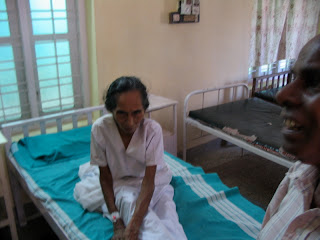
The 30-year-old X-Ray machine at the Rev. George Mathen Mission Hospital.
We spent Friday visiting hospitals and clinics started by the church in the Diocese of Madhaya Kerala. The Bishop Jacob Memorial Hospital provides a clinic for the residents of Pallom, a village on the shore of Vembanad Lake. Serving a poor population makes it hard for the clinic to expand in order to take care of the village's basic health needs.

With a part-time social worker, two resident medical officers, and visiting physician, the clinic and its director, Dr. Chinoy J.G. Chacku (right), are struggling to provide treatment for the growing problem of alcoholism in addition to providing basic health care. If the clinic can raise enough money, it hopes to start a home health care program for the elderly and also a care center for the terminally ill. Currently, there are few places that cater to the needs of the terminally ill in the area. The clinic is also active in educating the poor about AIDS, trying to erase the stigma of the disease so people will seek treatment and basic answers. An AIDS/HIV poster on one of the clinic's worn walls reads, "Reach out to people as Christ reached out."



With a part-time social worker, two resident medical officers, and visiting physician, the clinic and its director, Dr. Chinoy J.G. Chacku (right), are struggling to provide treatment for the growing problem of alcoholism in addition to providing basic health care. If the clinic can raise enough money, it hopes to start a home health care program for the elderly and also a care center for the terminally ill. Currently, there are few places that cater to the needs of the terminally ill in the area. The clinic is also active in educating the poor about AIDS, trying to erase the stigma of the disease so people will seek treatment and basic answers. An AIDS/HIV poster on one of the clinic's worn walls reads, "Reach out to people as Christ reached out."

Meanwhile, the Rev. George Matthen Mission Hospital finds its self in a similar bind: Started with the mission to aid the poor, but in danger of closing because of competition from private hospitals that cater to people who can afford to pay for their health care. The nonprofit mission hospital is managing to stay open -- barely. "The poor come first," says the priest at the CSI Holy Immanuel Church next door. But the hospital can't generate enough money to stay open from serving just the poor. Also, the hospital, located in the impoverished hills of Kerala, is the sole health-care facility for 15 kilometers in every direction. Without it, the basic health-care needs of the poor would not be served at all. To compete with other hospitals, while
maintaining its mission, the church is trying to raise $800,000 to build a modern, state-of-the-art hospital that the more affluent would be willing to use -- allowing the diocese to continue funding health-care programs for the area's poor.
-- allowing the diocese to continue funding health-care programs for the area's poor.
maintaining its mission, the church is trying to raise $800,000 to build a modern, state-of-the-art hospital that the more affluent would be willing to use
 -- allowing the diocese to continue funding health-care programs for the area's poor.
-- allowing the diocese to continue funding health-care programs for the area's poor.Of course, much of the money would have to come from outside the area. In the meantime, the current hospital is attempting operate in a detoriating building and with severely out-dated equipment. The X-Ray machine is more than 30 years old and on its last leg. The diocese can only afford to pay for a scattered assortment of prescription drugs in the hospital's pharmacy. Still, the sick come for what they can get. On Friday, the facility was teaming with patients, young and old but mostly poor.


No comments:
Post a Comment